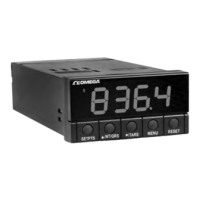
Do you have a question about the Omega DP25B-S and is the answer not in the manual?
| Brand | Omega |
|---|---|
| Model | DP25B-S |
| Category | Measuring Instruments |
| Language | English |
This manual covers setup and use of the Programmable Digital Meter.
Provides important information for setup and use.
Alerts about the risk of electric shock.
Alerts about circumstances affecting meter functionality.
Provides helpful hints.
Verify received equipment, check for damage, and report any issues.
Critical safety information for installation, operation, and EMC compliance.
Overview of the Digital Programmable Strain Meter, its capabilities, and applications.
Details the standard and optional features of the meter.
Lists optional accessories like covers and panel adapters.
Details the front panel layout, displays, and pushbuttons.
Describes the connectors and labels on the rear of the meter.
Describes the location of the rating and product label.
Instructions for configuring main board power jumpers.
Procedures for installing the meter into a panel cutout.
Wiring instructions for various sensor input types and excitation.
Details for connecting AC and DC power to the meter.
Instructions for connecting an external tare switch.
Diagrams for connecting output modules.
Procedure to select the appropriate input signal type for the meter.
Steps to set the decimal point display position.
Methods for scaling meter readings to engineering units.
Detailed steps for on-line calibration using known input values.
Procedure for scaling using transducer specifications and manual input.
Options for configuring reading parameters like ratiometric mode, resolution, and display type.
How to select the display color (Version B only).
Configuration options for Setpoint 1, including active band and latching.
How to set the active band for Setpoint 1.
How to configure Setpoint 1 latching behavior.
How to assign Setpoint 1 to net/gross readings.
Configuration options for Setpoint 2, including active band and latching.
How to set the active band for Setpoint 2.
How to configure Setpoint 2 latching behavior.
How to assign Setpoint 2 to net/gross readings.
Procedure to set the hysteresis (deadband) for Setpoint 1.
Procedure to set the hysteresis (deadband) for Setpoint 2.
Configuration options for analog output, including enabling and signal type.
Steps to enable or disable the analog output feature.
How to choose between current and voltage output signals.
How to assign analog output to net/gross reading or proportional control.
Procedure to scale and offset the analog output signal.
Practical examples demonstrating output scale and offset configuration.
Options for locking out meter settings and functions.
How to enable or disable the RESET button's function.
How to control user access to setpoint modifications.
How to configure the SETPTS button to show firmware version or setpoint value.
How to adjust display brightness (Version B only).
Steps to adjust the display brightness level.
Details input ranges, isolation, noise rejection, and resistance.
Specifies ADC technique, internal resolution, and read rate.
Lists accuracy parameters like error strain, tempco, and response time.
Specifications for relay outputs, including type, current, and voltage ratings.
Specifications for analog output, including signal type, level, function, and linearity.
Specifications for isolated analog output, similar to non-isolated.
Details AC/DC power requirements and fuse specifications.
Operating and storage temperature, and relative humidity limits.
Panel cutout dimensions, weight, case material, and protection rating.
Instructions for returning products for warranty or repair evaluation.